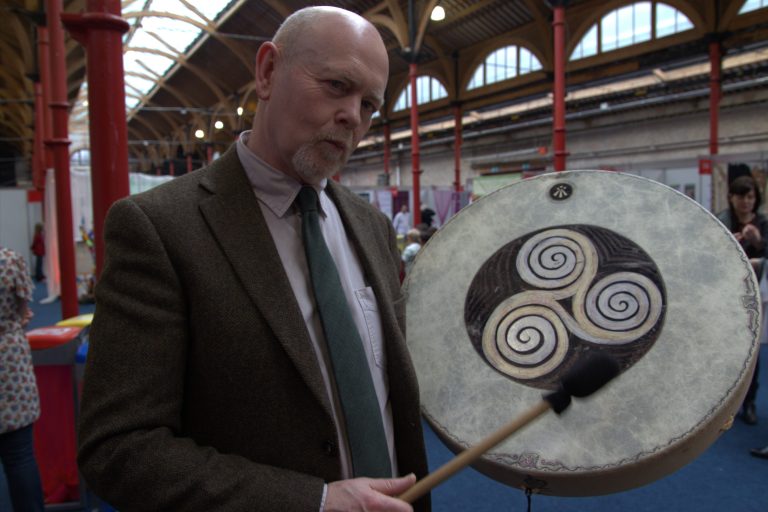
Image by Shweta Saraswat, © All Rights Reserved.
The Snakes are Still in Ireland: Pagans, Shamans, and Modern Druids in a Catholic World
It’s Friday night at The Magic Glass, a medium sized bar tucked inside the O’Callaghan Hotel in the center of Dublin. At first glance, the 40-odd people lounging inside seem like average Irish, glowing from the orange of the lamps and the heat of their drink. But they’ve rejected one of the key elements of what it means to be Irish: Catholicism and indeed Christianity.
A group of fit young men compare Celtic tattoos in one corner, a Wiccan crochets a snake doll in another, and a couple at the bar discusses an upcoming handfasting. This is a pagan moot, a regular meeting of the local pagan community including shamans, Wiccans, and Druids.
While such terms may conjure up images of people dancing naked by fire under the moonlight, contemporary paganism is simply the restoration of indigenous religions, especially that of ancient Europe. In recent decades, the Catholic Church has faced a steady decline in levels of practice and a cultural crisis, according to Olivia Cosgrove, co-editor of Ireland’s New Religious Movements. Consequently, non-religious or alternative spiritualities have become more widespread.
In the ethnographic study “Neo-Paganism in Ireland,” Jenny Butler writes that the spiritual movement encompasses a wide variety of beliefs and practices. But a common thread throughout contemporary paganism is the neo-pagan ritual. It usually involves the articulation of meaning about the nature of reality and is also a way to engage with certain energies believed to exist in the world.
But tonight, the only ritual happening is the social imbibing of alcohol. More of a laidback party than any sort of organized meeting with an agenda, the pagan moot is a chance for men and women on the spiritual margins to be with others like themselves.
And they need each other. In a country where 84 percent of the people call themselves Catholic, non-Christian residents in Ireland live in a world where laws and social norms still have the distinct tang of Catholic morality. Pagan weddings were not considered legal unions by the Irish government until 2009.
Raymond Sweeney, the national coordinator for Pagan Federation Ireland, has been one of the loudest voices demanding the legalization of pagan weddings. If it weren’t for the jovial look on his cherubic face as he gulps down his drink, his mammoth size and black leather vest would be intimidating.
“It’s not the message of Christianity, but the hardness of the Catholic churches and their interpretation of the Bible that was an issue for me.”
Raised Catholic, the 40-year-old proudly recalls when he was a bored 11-year-old sitting in a wooden pew during Mass. He triggered the fire alarm to get out, and his spontaneous act of rebellion worked better than he could have imagined. His parents never brought him back to church, wanting to avoid the trouble of any more of his sacrilegious shenanigans.
The young rebel’s curiosity led him to explore a range of pagan traditions, which has helped him in his role as a registered solemnizer of pagan weddings. When he’s not overseeing a handfasting — a ritual in which a couple literally “ties the knot” — he works as an electric engineer. His scientific side comes out when he uses physics as a metaphor to explain his own spirituality.
“If you shine a light through a prism, then put another prism next to it, it doesn’t change the light. You don’t see it through somebody else’s interpretation — you see it directly,” says Mr. Sweeney, describing the unmediated appeal of paganism over the hierarchical nature of Catholicism.
Paganism is open to a range of interpretations and traditions, but Mr. Sweeney lists three basic principles that unite them. The first is love and kinship with nature, followed by a positive morality expressed as, “Do what you will, as long as it harms none.” The last tenet is recognition of the divine, acknowledging both its female and male aspects.
While easy to dismiss as an eccentric outlier, Mr. Sweeney is just one example of the many Irish who are leaving the Church. The Irish-Catholic population is steadily diminishing, and a recent survey shows that religion ranks as the least important thing in people’s lives.
Disenchantment with the Catholic Church is a common sentiment at the pagan moot. Al Cowan, the founding organizer of the moot, strongly believes that the country’s identity and its relationship to religion is changing.
“There’ve been so many scandals about child-abusing priests that the Church has lost its hold. A new generation of people who are better educated and more savvy have the opinion — if you want to be a good Catholic that’s fine, but don’t impose it on me.”
Mr. Cowan didn’t grow up in a religious household, but his wife Mercedes Goncalves was raised Catholic in her native country of Portugal. She came to Ireland on a spiritual search and found love in the process when, five years ago, she and Mr. Cowan met at a pagan moot.
The Wiccan couple appreciates that they can share their beliefs with each other, but for Ms. Goncalves that meant leaving behind Catholicism. Her mother, though supportive now, initially felt that she had failed Ms. Goncalves by not passing on her religion.
“But I told her, ‘You gave us something much better — you gave us the ability to think for ourselves.”
Fluid Religion, Solid Heritage
Statistics on practitioners of pre-Christian Irish spirituality are few and far between. The community is unstructured in belief and body. But if the Mind, Body, Spirit International Festival in Dublin is any indication, interest in unorganized, non-Christian spirituality is thriving.
Inside the venue at the Royal Dublin Society, a long-haired man gives out animal psychic readings. A ‘modern’ bellydancer undulates on stage to the haunting tones of a didgeridoo. Then, there’s Martin Duffy.
In his modest tweed jacket, slim green tie and softly faded jeans, the established pyschotherapist looks like your average Dubliner on Grafton Street. Until he picks up his drum.
Beating his small drum at a quick, regular rhythm, Mr. Duffy attempts to tune into the tempo of the theta brainwave state, a deep meditative trance. Shamans believe that in this trance state they can access or “journey” to the spirit world. Techniques like these help shamans to reconnect with their inner emotional state as well as connect to other human beings, the Earth, and the greater mystery of existence.
According to Mr. Duffy, there are thousands of people in Ireland who dabble in shamanism, seeking what he calls “spiritual democracy.”
“In Ireland we’ve had all sorts of problems and scandals. So what Irish people are finding is that shamanism connects them directly to the source of their own divinity, and they don’t have to have it mediated through a priest or a rabbi or another person. They can go and find that out for themselves.”
Mr. Duffy also grew up Roman Catholic, but was raised by a mother and grandfather who were traditional folk healers. When he explored for a deeper meaning in Christianity, he found that Jesus Christ himself was a healer.
“That was the aspect of Christ that attracted me the most. Laying on of hands, casting out of demons, rising from dead and all of that. So I realized that Christ was a shaman, meaning one who sees beyond the everyday consciousness and is able to commune with the Holy Spirit.”
Mr. Duffy still goes to church periodically, just as he goes to Buddhist temples and pagan gatherings on the equinox. His religion is not a religion at all — it’s a worldview that is fluid, non-dogmatic and self-oriented. In other words, it’s far removed from Roman Catholicism.
As for his daily shamanic practice, Mr. Duffy describes it as “stalking awareness,” which means being simultaneously alert to the outside world and his internal emotional state. Unlike a church, his place of worship is not bound by walls.
“We do rituals on the land, because Shamanism and Druidism is an earth-based spirituality. Our cathedrals and our churches are the sky and the trees and nature.”
Sharing Mr. Duffy’s stall at the festival is Ann Peard, a bright 67-year-old woman dressed in a long white tunic and green mantle. She was raised in a Catholic-Anglican household, a one-time taboo mix. Discovering an alternative spiritual path 16 years ago, she practices a combination of Druidism and shamanism that celebrates the cycles of life, the seasons, and the power of natural healing.
“It comes from the heart,” says Ms. Peard, who lives on the sacred Hill of Tara among the monuments of indigenous Irish from thousands of years ago. “Ceremonies can be as simple or fancy as you like. You don’t need all the paraphernalia or a fancy altar. It’s intention-based.”
On St. Patrick’s Day, Ms. Peard happily sported a tuft of shamrock alongside her Druid brooches. Her practice of Celtic spirituality is as much a display of Irish pride.
“Shamanism changed my life. It’s in my DNA, in the land here in Ireland, and it’s coming up through me.”
Even as the Catholic population shrinks, even as non-Christian immigrants pour into the city, even as the pagan community stakes its claim beyond the margins of religious life, Ireland is still a country of faith. “There is an innate sense of spirituality in Ireland that you don’t find in other countries,” Mr. Duffy says. “I don’t believe one religion is better than the other, as long as you connect to the divine.”
Paganism can seem like an attractive alternative to the crush of mainstream religious thought, but pagan leader Raymond Sweeney fears that Celtic spirituality will be trivialized as a temporary fling for lost souls.
“Unfortunately, people attracted to paganism want the exotic. My goal is to remove ‘pagan’ from being a pejorative term. I want normality.”
It’s a steep hill to climb, but Mr. Sweeney believes that the key to normalizing pagan traditions is to simply leave it alone.
“It’s something you feel. You either feel it or you don’t. How do you know you’re pagan? How do you know when you’re in love?”



Share your reflection